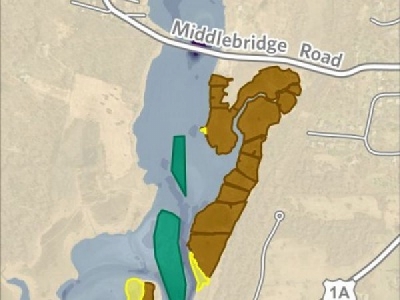
Posted on October 27, 2016
By Margo Sullivan, Patch
It turns out it takes pains for salt marshes to be beautiful, too.
Dredging is starting soon in the Chafee Refuge salt marsh to improve habitat for marine fish and also to “enable the marsh to withstand the impacts of sea-level rise and coastal storm surge,” according to Tim Mooney, of the Nature Conservancy.
“In late October, crews will position equipment on barges in the Narrow River and begin dredging within designated areas, from Middlebridge to Sedge Island, near Sprague Bridge,” he said.
The expectation is the staging will go up, starting Oct. 26, and the dredging will start a week later.
“The dredged material will be placed on the existing salt marsh and then spread across targeted areas, adding up to six inches of elevation to the marsh,” he said. “The work – known as thin-layer deposition – is expected to be completed by the end of December.”
Once it starts, boaters are urged to use caution and approach the equipment only at headway speed, Mooney said. “The river access point on the north side of Sprague Bridge will be closed during the dredging activities.”
Over the short term, the results won’t be pretty, said Charlie Vandemoer, U.S. Fish and Wildlife Refuge manager.
“For kayakers and other visitors to the refuge, the area south of Middlebridge may look more like a mudflat than a salt marsh once the construction work is finished,” he said.
“But if we do nothing, we risk losing the whole marsh. The salt marsh just can’t keep up with rising seas,” he said. “Raising the elevation is our only shot at saving it for the long-term.”
The Fish and Wildlife Service and The Nature Conservancy are working with partners, including the Rhode Island Coastal Resources Management Council, on the project, Mooney said. “Over a dozen federal, state, and local organizations came together to develop the restoration plan.”
It’s expected to “improve habitat for marine fish by enhancing the growth of eel grass and creating
deeper channels for cool water refugia,” he said. It’s also part of the 14-state recovery in the aftermath of Hurricane Sandy.
“The project focuses on 30 acres of marsh on the eastern shore of the Narrow River estuary, opposite Pettaquamscutt Cove,” Mooney added. “The work is being carried out under a $1.4 million cooperative agreement between The Nature Conservancy and the U.S. Fish and Wildlife Service, supported by federal funding for Hurricane Sandy recovery.”
According to Scott Comings, associate state director for The Nature Conservancy, more than fish thrive in the refuge.
“The Chafee Refuge provides outstanding habitat for salt marsh sparrows, egrets, black ducks, and many other water birds,” he said and called the marshes “irreplaceable natural resources.” Hundreds of species of plants, fish, shellfish, birds and mammals rely on the salt marshes for habitat.
The construction is supposed to be over in December. Sections will be replanted in the spring, and it will take two years for the vegetation to grow back, he said.
Source: Patch





